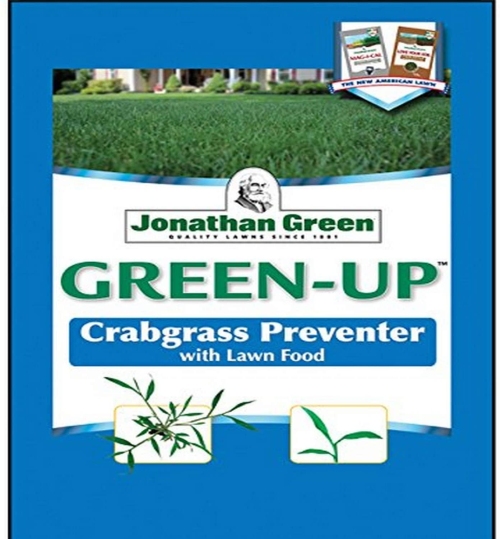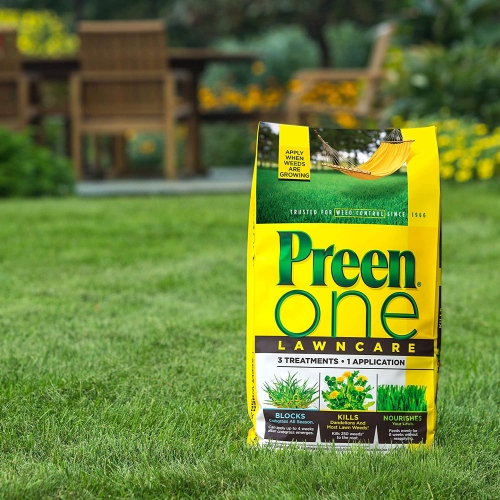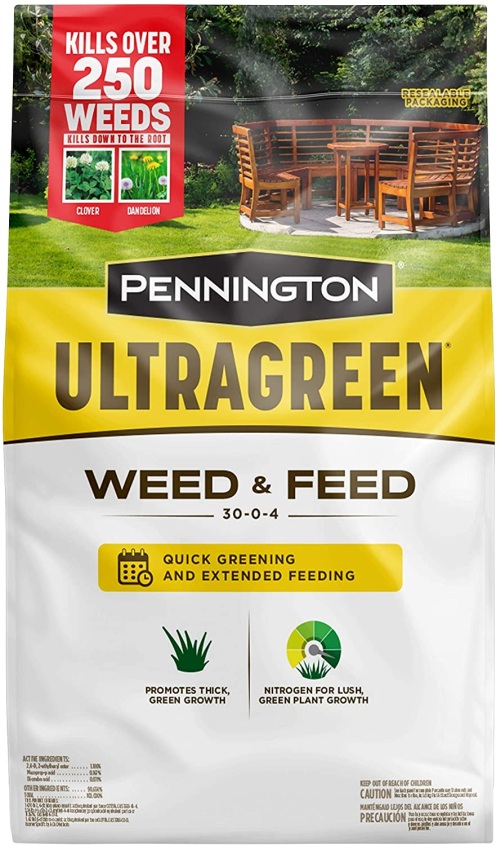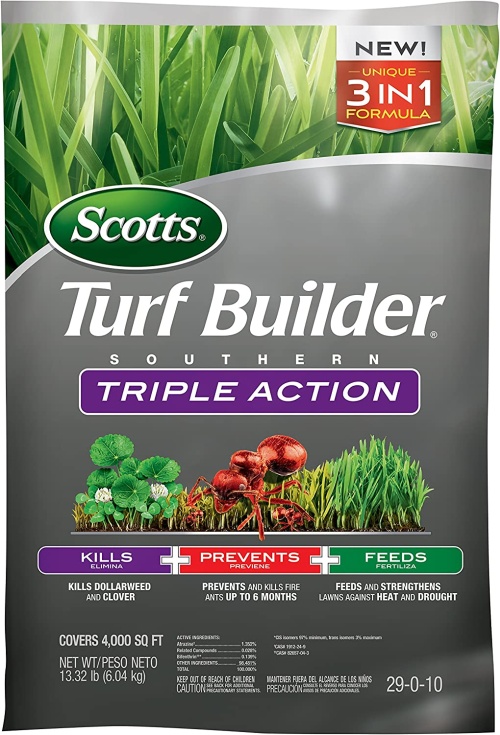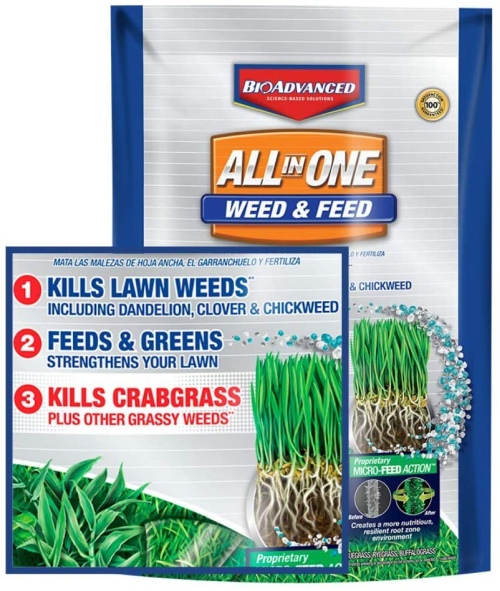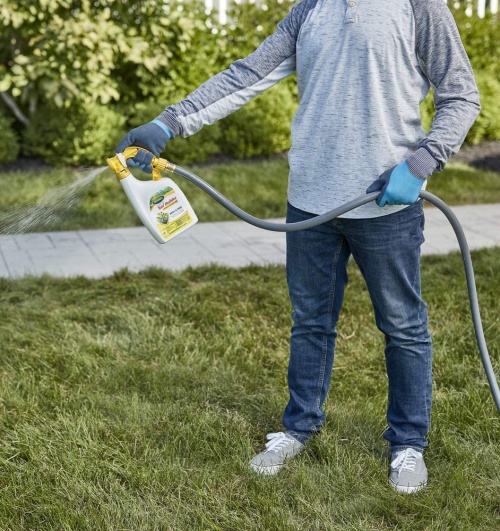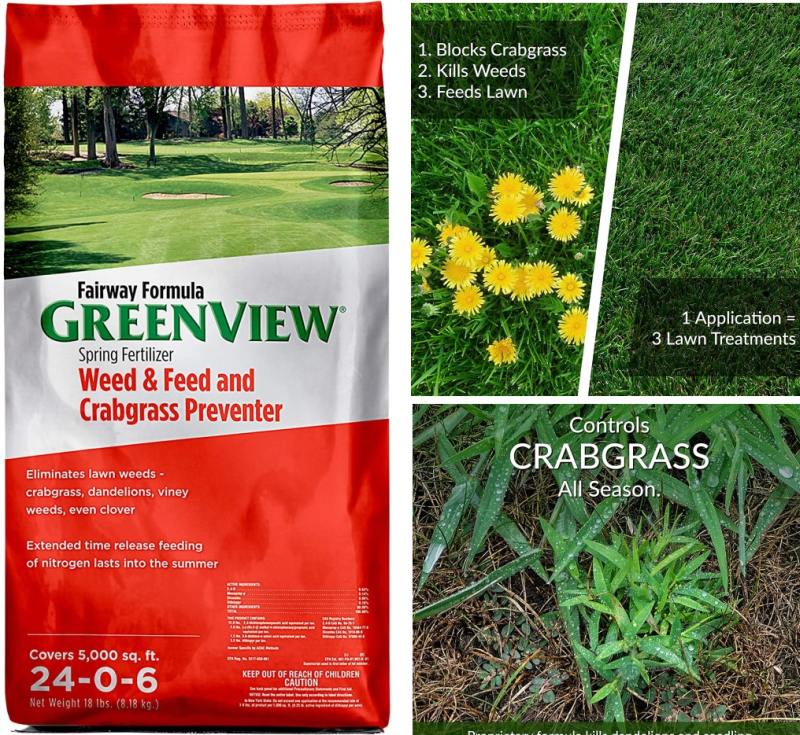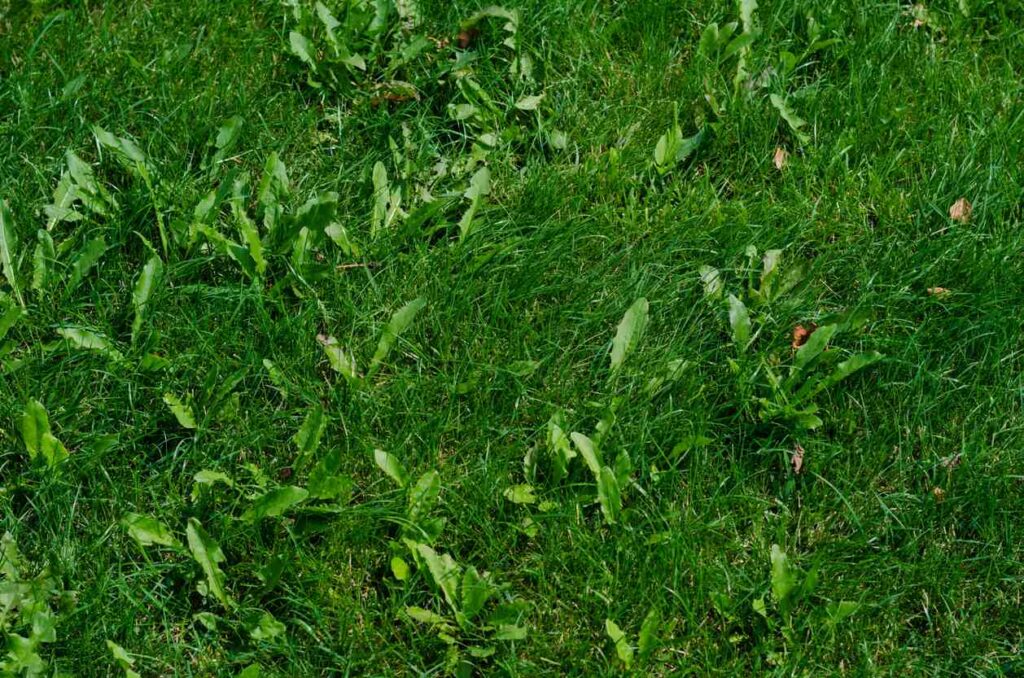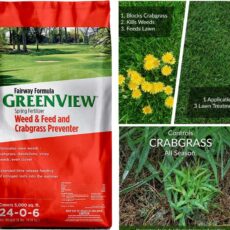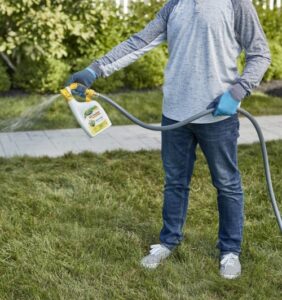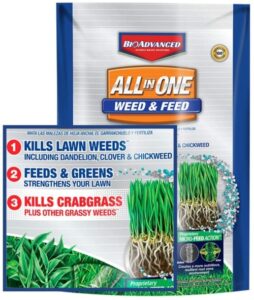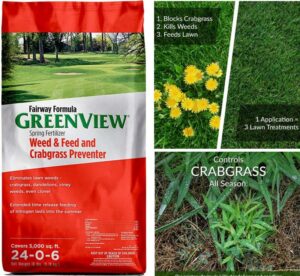7 Best Weed and Feed Reviews – Give Your Lawn A Professional Look The Easy Way
When your lawn falls short of your expectations despite all the hard work you put into it, don’t blame yourself. It’s not you, it’s the lawn. Luckily, lawn problems, no matter how serious, are usually easy to fix with the right tools. This is not about working harder, but working smarter.
From weeds to yellow spots and barren patches, lawn problems can be a real headache. Not only does a meticulous lawn enhance your curb appeal, but it also gives you bragging rights in the neighborhood.
But as we all know, it’s not easy to keep your lawn looking its best every day all year round. The grass looks pale and sickly. Clumps of weed are sprouting everywhere, and heavy foot traffic has all but flattened the turfgrass. It looks like you’re in need of a double-action product that kills the weeds while feeding the grass at the same time.
Weed and Feed products do just that. They eliminate various types of weeds from your lawn and offer your grass the nutrients they need. Here we review the top weed and feed products in the market detailing their advantages and drawbacks. We follow that with a comprehensive buying guide to help you choose the right product for your specific lawn needs.
Best Weed and Feed Reviews
Whether your lawn has bare spots, yellow grass, or a weed infestation, the following weed and feed fertilizers offer answers to your lawn problems. You’ll be able to weed-proof your lawn while feeding your turfgrass with minimal effort.
1. GreenView Fairway Formula Fertilizer (Editor’s Choice)
We start off with the best of the pack. If you don’t have either the time or patience to keep the weeds on your lawn in check and take care of the feeding of the grass, then GreenView Fairway Formula Fertilizer might be what you’re looking for. This pro-grade fertilizer makes it easy to achieve a professional lawn appearance without putting in too much work.
What makes this fertilizer and weed-killer combo stand out is the wide range of weeds it targets. It focuses specifically on difficult lawn weeds such as crabgrass. Not only does it kill this lawn bane, but it blocks it from returning. People who had to struggle with crabgrass in the past know how stubborn this weed is and how it often comes back the next spring. So it’s a plus point for this product with its proprietary formula that it keeps crabgrass from invading your lawn after applying it.
Not only does GreenView eliminate crabgrass but it’s also effective against over 200 other weeds including the pesky dandelions. But that’s only half the story. Since we’re talking about weed and feed fertilizers, then the feeding part is just as important as killing and blocking weeds.
Greenview uses a 65 percent slow-release formula that’s high on nitrogen to feed the grass for up to 12 weeks after each application. The 24-0-6 formula is suitable for many turfgrass varieties as long as the roots are established in the soil.
On the downside, you need to watch out for young grass on the lawn. The high concentration of nitrogen in the fertilizer could burn the tender roots of yet-to-establish turfgrass. If you have grass varieties that are sensitive to nitrogen such as Saint Augustine or dichondra grass, you shouldn’t use this fertilizer.
Pros
- Blocks crabgrass.
- Effective against 200 weeds.
- Proprietary 65 percent slow-release formula.
- Covers 5,000 square feet.
Cons
- Not suitable for sensitive turfgrass.
- Needs heavier application to fight off clovers.
2. Scotts Liquid Turf Builder (Best Value)
Let’s face it. The main reason you’re using a weed and feed fertilizer is that you don’t have time to deal with weed infestation while also feeding the grass. I get it. It’s a lot of work. So when a product like Scotts Liquid Turf Builder comes in a nifty easy-to-use bottle with a hose, you know you’re in for a treat. All you have to do is point the nozzle and spray the liquid. It doesn’t get any easier than that.
This product kills a wide range of weeds that attack lawns both in the northern and southern parts of the country. This list includes pigweed, buckhorn, ragweed, chickweed, ground ivy, plantain, henbit, spurge, knotweed, oxalis, lambsquarters, and poison ivy. It also does a good job taking care of dandelions and clover.
As a post-emergent pesticide, Liquid Turf Builder is more efficient against weeds already growing on your lawn. It doesn’t prevent them from starting or stop them from coming back. So you’ll need to use it whenever you see weeds emerging among the turfgrass. The sooner you apply it the better results you get. With some stubborn weeds, especially clover, you might need to use another application about 3 weeks after the first one.
The container covers an area of about 6,000 square feet giving you the best value for your money. It has a custom 25-0-2 formula with a high concentration of nitrogen, zero phosphorus, and trace amounts of potassium.
Using this product is both safe and convenient. However, it has a major downside. It doesn’t work against crabgrass, either in pre-emergent or post-emergent capacities. That’s a major disadvantage and if you have crabgrass on your lawn, you’ll have to look for another product on this list.
Pros
- Covers 6,000 square feet.
- Effective against growing broadleaf weeds.
- Good value for money.
Cons
- Doesn’t kill crabgrass.
- Doesn’t work as a pre-emergent pesticide.
3. Bioadvanced All in One
We all know how tough it is to get rid of crabgrass. I’m not just talking about keeping it off the lawn, but actually killing the growing weed after it has taken root. So one of the criteria that separate a top-notch weed and feed fertilizer from the rest of the pack is its ability to attack crabgrass after emerging and eliminating it. In that respect, Bioadvanced All in One delivers in spades.
After it takes care of crabgrass, it turns to dandelions, chickweed, clover, spotted spurge. It shows satisfying results eliminating a long list of over 200 types of weeds. So you can use it as a post-emergent pesticide. However, it doesn’t block crabgrass from returning to the lawn. You’ll need to apply it whenever you spot emerging weeds.
In addition to its weed killing qualities, Bioadvanced uses a proprietary technology called micro-feed action that unlocked nutrients in the soil while also improving nutrient uptake.
This product is suitable for Northern turfgrass including, Fescue, Seashore Paspalum, Zoysia grass, Buffalo grass, Kentucky Bluegrass, and Ryegrass. The package protects and feeds about 5,000 square feet.
On the downside, you cannot use this product with other types of turfgrass. Also, when applied to Bermudagrass, you might notice the grass turning yellow. It will take up to a week for the grass to regain its lush green color.
Pros
- Kill crabgrass after emerging.
- Effective against 200 types of weed.
- Easy to spread and use.
- Micro-feed action.
Cons
- Causes Bermudagrass discoloration.
- Limited to only Northern turfgrass.
4. Scotts Turf Builder Southern Triple Action
Scotts is an established brand in the world of weed killers and fertilizers. So when the Scotts Turf Builder Southern Triple Action package arrived at my door, I already had high expectations for it. And I have to say I wasn’t disappointed. The Triple Action delivered on all three fronts as advertised. I had a tough time keeping dollar weeds and oxalis off my lawn but one application in the early spring of this weed and feed was enough to eliminate these stubborn weeds. I still applied it again later that spring just to be on the safe side.
With a decent coverage rate of 4,000 square feet, this product is safe to use with many Southern turfgrass varieties. It works well on Zoysia grass, carpet grass, centipede grass, and Saint Augustine grass.
On the downside, you can only apply it in the spring with temperature in the mid-seventies. The formula doesn’t work in cold temperatures. Also, it’s not safe to apply it on newly mowed grass or tender grass that hasn’t established in the soil yet. After spraying, you should keep pets and children away from the lawn for at least one day until the pesticide has dissipated.
Although it works well as a pre-emergent pesticide, Scotts will not have much success against crabgrass once it takes root in the lawn. That’s the main drawback that kept it from contending for the top place on this list.
Pros
- Works well against growing broadleaf weeds.
- Suitable for Southern turfgrass.
- Covers 4,000 square feet.
Cons
- Not safe to use on newly seeded areas.
- Doesn’t kill growing crabgrass.
5. Pennington UltraGreen
As we have seen so far, some weed and feed fertilizers work only on northern grass while others specialize in Southern turfgrass varieties. But what if you want to use a product that works on all types of turfgrass? Pennington UltraGreen is that kind of product that handles a wide variety of weeds as well as grass types.
Its ability to aggressively go after over 250 types of weeds is impressive. You can use it against anything from dandelions and dollar weed to henbits, plantain, chickweed, and white clover. The conveniently resealable package offers protection to an area of 5,000 square feet.
One thing to watch out for with the UltraGreen is its high concentration of nitrogen. With a 10.5 percent slow-release nitrogen in a 30-0-4 formula, it has the highest nitrogen ratio among the products on this list. So use it with caution on sensitive turfgrass and make sure the roots are well established in the soil before you apply the fertilizer. It could burn tender shoots of grass and sensitive roots.
Another drawback about this product is that you can only use it in the late spring when the temperature is between 60 degrees to 80 degrees Fahrenheit. Also, it doesn’t work against crabgrass.
And while it advertises its suitability for Northern as well as Southern turfgrass, you should not use this product with Saint Augustine grass. The extra nitrogen in the ingredients would burn the grass or at least stunt its growth.
Pros
- Suitable for Northern and Southern turfgrass varieties.
- Covers 5,000 square feet.
- Effective against 250 types of broadleaf weed.
Cons
- Not good against crabgrass.
- Not suitable for Saint Augustine grass.
6. Preen 2164169 One LawnCare
While using weed and feed fertilizers, you need to be wary of the timing of the applications. Not only are you targeting pesky weeds, but you’re also feeding the grass with every application. In other words, you can’t just use it any time of the year since you might trigger growth in dormant grass in the fall or winter which has devastating consequences. But with Preen 2164169, you don’t have to worry about that.
Preen is safe to use three out of four seasons. You can use it in the spring, summer, and fall. Furthermore, you can use it to fight off fully grown crabgrass. This is what makes Preen stand out among other weed and feeds. It is still effective against crabgrass that’s about 4 weeks old. So you can use it as both a pre-emergent and a post-emergent weed killer.
But it’s not just crabgrass and dandelions. Preen shows satisfying results eliminating more than 250 types of broadleaf weeds on the lawn. This includes white clover, a notoriously difficult weed to manage once it takes root on your lawn.
The slow-release formula allows this fertilizer to keep feeding your grass for up to 8 weeks after each application. It has a custom 24-0-6 formula with zero phosphorus and covers over 5,000 square feet of lawn offering both nutrition and protection.
That said, you shouldn’t use this product if you have carpet grass, colonial bentgrass, Saint Augustine grass, or dichondra. The high concentrations of nitrogen could cause injury to the turfgrass.
Pros
- Can be used any time of the year except in winter.
- Eliminates crabgrass 4 weeks after emergence.
- Zero phosphorus formula.
- Effective against 250 types of weed.
Cons
- A little pricey.
- Requires more than one application to get rid of clover.
7. Jonathan Green Green-Up
A newcomer to the world of weed and feed, Jonathan Green Green-Up is already getting the attention of gardeners and homeowners. Its claim to fame is its focus on crabgrass. Not only does it aggressively eliminate growing crabgrass, but it also blocks it from returning to the lawn. So it works well both as a pre-emergence and a post-emergence herbicide.
Helping Green-Up perform is a new proprietary technology called dimension Crabgrass control. It targets crabgrass in the lawn and effectively kills the invasive weed without affecting the turfgrass or other vegetation in its vicinity. You can use this product on crabgrass already growing.
This is something that sets it apart from other weed and feeds on this list. Usually, after crabgrass has reached a certain maturity, weed killers become less effective. But Green-Up can be used on crabgrass 4 weeks later than other pesticides. Applying it isn’t limited to spring the way it is with other brands. You can use it all season without having undesirable side effects on the soil or the turfgrass.
Along with crabgrass, this weed killer also eliminates other broadleaf weeds including spurge, bittercress, henbit, and chickweed among others. The package covers 5,000 square feet of the lawn both protecting and feeding in the turfgrass. And on the feeding side, the new formula has 25 percent slow-release nitrogen, doesn’t have any phosphorus, and is non-staining.
On the downside, you’ll have to wait for 4 months after applying the weed killer before you can seed the lawn. This limits your options when choosing the right time to apply the weedkiller.
Pros
- Targets crabgrass before and after emergence.
- Eliminates crabgrass 4 weeks later than other similar products.
- Protects and feeds 5,000 square feet.
Cons
- Need to wait 4 months after application to seed the lawn.
Weed and Feed Buying Guide
After this comprehensive review of the most popular weed and feed fertilizers in the market, let’s take a look at common lawn problems, the different types of fertilizers, and the best times to fertilize your lawn and apply weed and feed products.
Common Lawn Problems
Crabgrass and invasive weeds are not the only problems you might have to deal with on your lawn. Even a well-maintained lawn is prone to yellowing problems due to compact soil, poor soil, inadequate watering, excessive heat in the summer, or frost in the fall and winter.
Pests might also attack your turfgrass. White grubs, billbugs, and cranberry girdlers are common pests that feed on the grass and weaken its root system, creating yellow spots all over the lawn. You can use GreenView to tackle most of these problems including weak or mal-nourished grass.
Another problem you have to watch out for is fungi. Necrotic ring fungus is a hard infection to treat. It creates yellow rings in the lawn that can stay for three years. You’ll often have to turn up the soil, uproot the infected grass, and reseed the lawn.
Spilled chemicals can have a devastating impact on the soil and the quality of the grass as well. Whether it’s gasoline from your vehicle or pet urine, the roots of the grass are no match to the high concentrations of ammonia and gasoline in the soil. To solve this problem you’ll have to dig up the contaminated soil, supply fresh soil, and reseed the bare patches.
Check the Soil
Before you seed your lawn, you should take the necessary steps to test the soil to make sure the turfgrass you chose will actually grow on the lawn. Soil testing not only measures the presence of different nutrients in the soil but also the pH levels. To start with you need to make sure there’s a good balance of the three main nutrients, nitrogen, potassium, and phosphorus in the soil. Grass often needs more nitrogen than potassium and it just requires trace amounts of phosphorus in the soil.
You can use a pH meter to check the acidity levels of the soil and add coarse sand or perlite to adjust these levels.
On top of that, you need to test the soil’s texture and drainage. Almost all types of turfgrass need a well-drained and loamy soil. Loamy soil has more silt and sand than clay which improves its drainage. To check that your soil has the right texture, fill the palm of your hand with soil and close your hand tightly. If the soil turns into a clump in your hand then it needs more perlite and sand.
Check the soil drainage in your lawn by digging a hole a few inches deep. Fill the hole with water and see how fast the water disappears. If it takes a long time for the soil to absorb the water, then your lawn is not well-drained. Fix that problem by adding organic material and coarse sand.
Types of Weed and Feed
When selecting the best weed and feed fertilizer for your lawn, you often have to make a choice between the two main types, liquid or granular. Each has its advantages and drawbacks.
- Liquid: You will often use liquid weed and feed if you have a small lawn or backyard. It is often easier and more convenient to apply than granular products. The container often has concentrated liquid and you’ll need to connect it to your garden hose and start spraying. The whole process can take no more than a half-hour to cover your lawn. Some products such as Scotts Liquid Turf Builder have a lower risk of burning the grass since you can adjust the water flow as well as the concentration of the fertilizer according to your needs.
- Granular: If you have a large lawn, then granular weed and feeds are a better option. You load the spreader with the fertilizer and criss-cross the lawn until you’re done. There’s less risk of spillage or stains with granular fertilizers. GreenView is an excellent example of this type. It doesn’t require diluting or mixing with water which makes it less messy. This is the recommended type for lawns larger than a quarter acre but less than one acre.
Best Times to Fertilize the Lawn
When it comes to fertilizing your lawn, timing is of the essence. While some weed and feeds are limited to the early spring in warm climates and late spring in cold ones, other products can be applied all season without time limitations. In general, you should wait for the air temperature to go above 55 degrees Fahrenheit before you apply the fertilizer.
Ideally, from mid-April onwards is the right time to fertilize your lawn for most parts of the United States. Always pick a warm day and avoid applying weed and feed on rainy days or during strong winds. This could blow away the granules of fertilizer or steer them to where you least want them.
After the first application in mid-April, you’ll need to follow up with another in Mid-may. Depending on the soil quality you will need to apply the weed and feed between six to eight weeks throughout the summer and mid-fall. If you notice weeds emerging in your lawn between applications, you can use the weed and feed in a more focused fashion on the infected areas.
Between October and April, you should hold back the fertilizer. Dormant grass doesn’t need fertilizing since it could trigger new growth during the cold winter.
Weed and Feed FAQs
If you’re new to using weed and feed, you might still have some unanswered questions. Here we answer the most common questions.
How does Weed and Feed work?
The way weed and feed products approach killing weed depends on the type of weed these products target. Generally speaking, there are two types of weeds that attack your lawn. The first is broadleaf weeds such as clover, dandelions, ground ivy, and others. Weed and feed brands such as Scotts and Preen would often attach the herbicide to the leaves and roots of the weeds in the first phase of the process.
The second type of weed is crabgrass which is very common and harder to get rid of. Weed and feed brands such as BioAdvanced and GreenView do a good job of eliminating this stubborn weed. Usually, they add a second phase that targets narrow leaf weeds. You might need to use more than one application to fully remove crabgrass and other narrow-leaf weeds from your lawn.
The final phase of the weed and feed process is the feeding part. While the product is killing the weed, your grass also gets valuable nutrients and plant food supplements that give the lawn a lush green look. Most products are high in nitrogen and low in potassium with zero content of phosphorus. That’s the right nutrient formula that your grass needs. However since some products have a higher concentration of nitrogen than others, you need to read the instructions carefully to apply the fertilizer in the right dosage.
How do I apply Weed and Feed?
Since there are two types of weed and feed, how you apply the fertilizer depends on the type you choose. Granular types such as BioAdvance and GreenView would usually require you to use a spreader. This helps you spread the fertilizer evenly across the lawn and prevent damage to the turfgrass. Even if you have a small lawn, resist the temptation to use your hands to spread the material. Many good lawns were ruined when clumps of fertilizer landed on certain spots while other areas remained untouched.
If your lawn is too small (less than a quarter acre) for a spreader, you might opt for a liquid weed and feed such as Scotts Liquid Turf Builder. It’s easy to use and only requires you to connect the container to a garden hose. Turn on the water and aim the nozzle at the lawn. When you’re done, release the handle and turn off the water. This is usually the easiest way to apply this type of liquid fertilizer.
There are other liquid products that require a more elaborate way of mixing the concentrated material with water before you can apply. We didn’t review these products since they’re a lot of hassle and can be messy to mix and apply.
How many Weed and Feed applications do I need?
The number of applications of weed and feed on your lawn depends on the type of turfgrass you have and the weed infestation. But in general, the first application in early or late spring (depending on the climate) is a good starter to nourish the grass at the beginning of the growing cycle. This early application also takes care of the sprouting weeds that could take advantage of the warming temperatures and the rainfall to spread across the lawn.
In most cases, you’ll need to apply weed and feed at least once every two months between April and October every year. If you need to fight emerging weeds between applications, then aim for a concentrated application that targets only the infested areas in the lawn.
The Last Word
We have taken a whirlwind tour of the most popular weed and feed products available online. We covered the good points and drawbacks of each product then detailed the main features to look for when buying a weed and feed fertilizer for your lawn.
After this exhaustive guide of weed and feed fertilizers, we recommend GreenView Fairway Formula Fertilizer. As both a pre-emergent and post-emergent herbicide, It does a good job eliminating crabgrass from your lawn and blocking it from coming back. The granular type product doesn’t stain and is easy to apply using a spreader. The package covers 5,000 square feet which is more than enough for most average-sized lawns. The product has a 65 percent slow-release formula that will feed the grass for weeks after each application.
If you’re on a budget, we recommend Scotts Liquid Turf Builder. The liquid fertilizer is easy to use and gives you a bang for your buck. The post-emergent herbicide works effectively against a wide variety of broadleaf weeds. It has an affordable price and one container protects and feeds about 6,000 square feet of the lawn.
